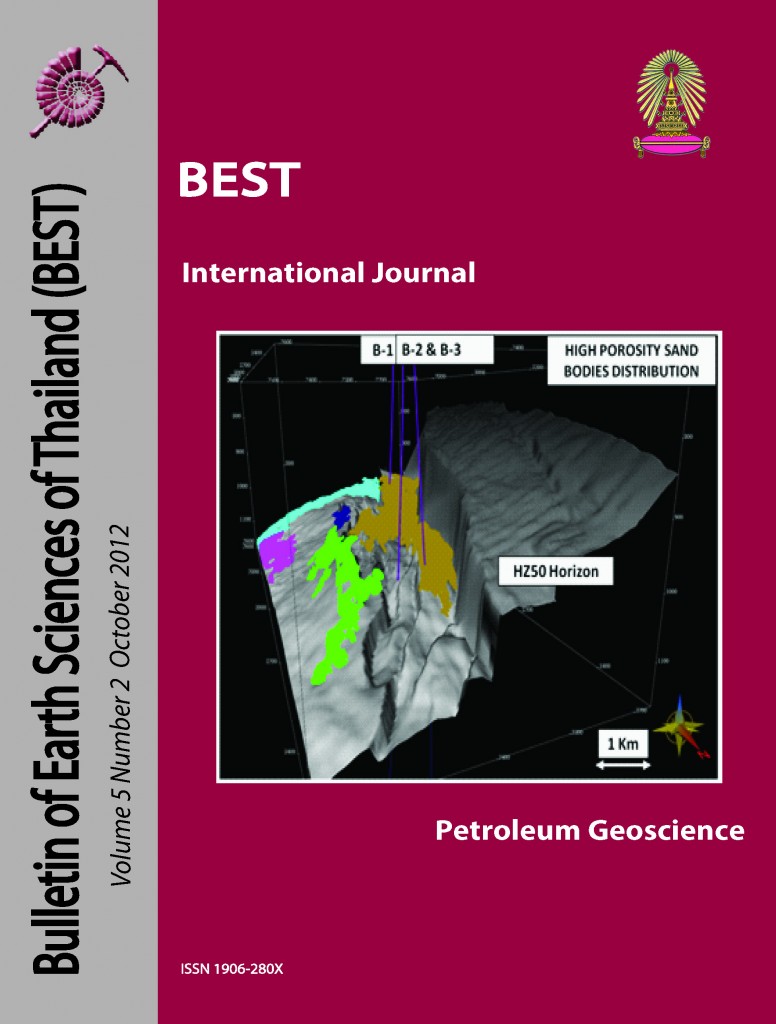Structural Evolution of the Songkhla Basin, Gulf of Thailand: A Palinspastic Restoration Study
Main Article Content
Abstract
The structure styles of Songkhla Basin are not well known as compared to other Cenozoic basins of the Gulf of Thailand. This study describes the results of 2D and 3D seismic data interpretation and restoration of key sections. Inversion occurred as local phenomena along eastern and western margin of the basin. The timing of initiation and cessation of the inversion is different in different parts of the basin. Onlap on anticlinal feature indicates that along the western margin in the center of the basin inversion ceased by Late Oligocene. While, in relatively southern part it ended in Middle Oligocene. Palinspastic restoration shows that rifting initiated along N-S oriented faults in the Eocene?, characterized by the thick syn-rift package in the western part of the basin. It also observed that along the eastern margin inversion started in Early Oligocene in northern sections while relatively southern sections show initiation of inverted features in Late Oligocene. This local inversion along the eastern margin lasted until Early Miocene. Coherency and phase slices show NW-SE discontinuity, which at some places cut cross the regional N-S faults. These are also associated with compressional features as observed on arbitrary perpendicular seismic sections. These discontinuities are interpreted as faults influenced by pre-rift fabric. Possible hydrocarbon traps are titled fault blocks, faulted anticlines and rollover close to boundary faults
Article Details

This work is licensed under a Creative Commons Attribution-NonCommercial-NoDerivatives 4.0 International License.
Copyright © 2008 Department of Geology, Faculty of Science, Chulalongkorn University. Parts of an article can be photocopied or reproduced without prior written permission from the author(s), but due acknowledgments should be stated or cited accordingly.
References
Groshong, R. H., 2008, 3D Structural geology: a Practial Guide to Quantitative Surface and Subsurface Map Interpretation: Verlag Berlin Heidelberg, Springer, 400 p.
Kornsawan, A., and C. K. Morley, 2002, The origin and evolution of complex transfer zones (graben shifts) in conjugate fault systems around the Funan Field, Pattani Basin, Gulf of Thailand: Journal of Structural Geology, v. 24, p. 435-449.
Morley, C. K., N. Woganan, N. Sankumarn, T. B. Hoon, A. Alief, M. Simmons, 2001, Late Oligocene-Recent stress evolution in rift basins of northern and central Thailand: implications for escape tectonics: Tectonophysics, p. 115-150.
Morley, C. K., C. Haranya, W. Phoosongsee, S. Pongwapee, A. Kornsawan, and N. Wonganan, 2004, Activation of rift oblique and rift parallel pre-existing fabrics during extension and their effect on deformation style: examples from the rifts of Thailand: Journal of Structural Geology, v. 26, p. 1803-1829.
Morley, C. K., and A. Racey, 2011, Tertiary stratigraphy, in M. F. Ridd, A. J. Barber, and M. J. Crow, The Geology of Thailand: London, Geological Society, p. 223-272.
Polachan, S., S. Pradidtan, C. Tongtaow, S. Janmaha, K. Intarawijitr, and C. Sangsuwan, 1991, Development of Cenozoic basin in Thailand: Marine and Petroleum Geology, v. 8, p. 84-97.
Racey, A., 2011, Petroleum geology, in M. F. Ridd, A. J. Barber, and M. J. Crow, The Geology of Thailand: London, Geological Society, p. 351-392.
Supriatna, J. M., 2011, Maturity modeling of the Songkhla Basin, Master Thesis, Chulalongkorn University, Thailand.


